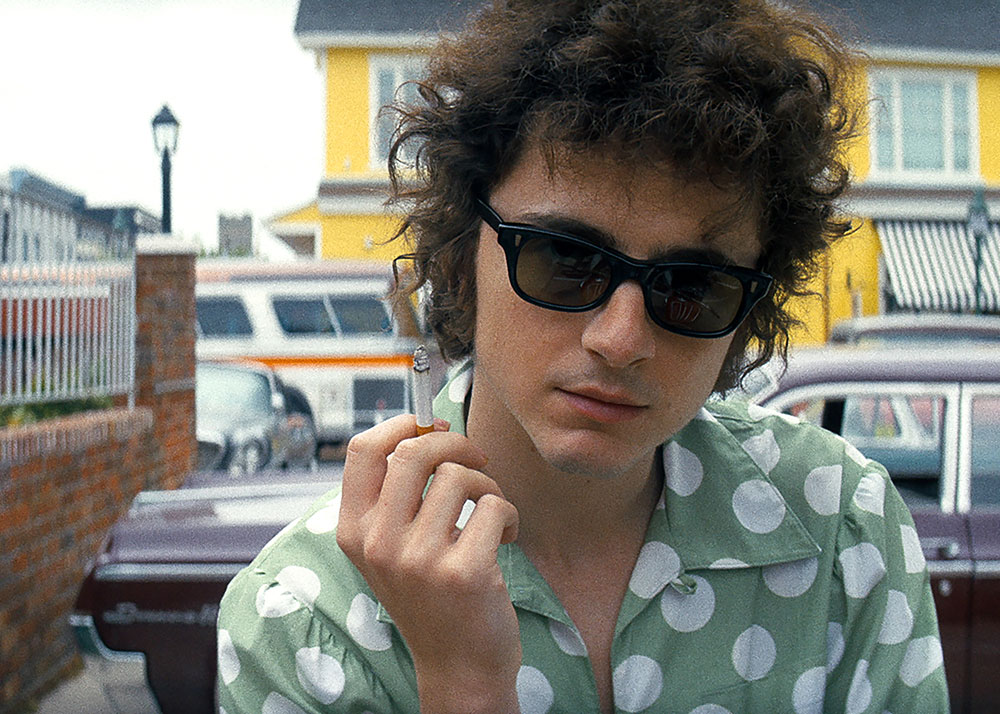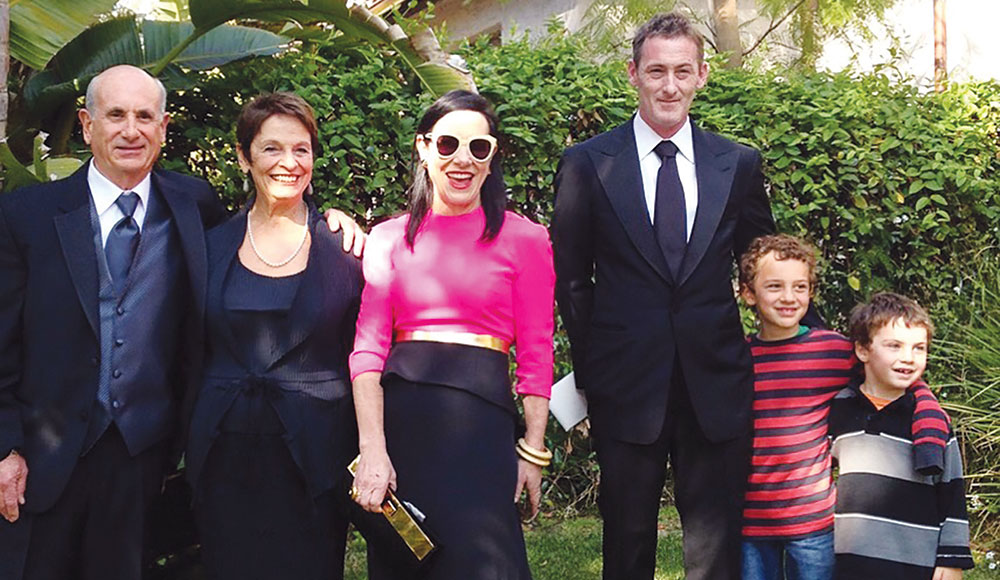On Oscar night, Santa Cruzans have a rare chance to root for a homegrown talent, as Arianne Phillips is announced at the Academy Awards as a nominee for her costume design on A Complete Unknown.
The movie, starring Timothée Chalamet and Elle Fanning, portrays the momentous first years of Bob Dylan’s rise from aspiring folk singer to chart-topping icon at the forefront of a counterculture.
Phillips’ story is filled with kismet and coincidence—a career that seems as inevitable as it is unlikely—with Santa Cruz serving as a thrilling launch pad and a happy splash-down.
“I did not become a costume designer in the traditional way,” Phillips says. “Most costume designers start with studying theater design or pattern making at college, and that would lead to summer-stock or theater, eventually leading to film as a production assistant and working up the ladder. I did none of that. I started as a stylist who is essentially a hunter-gatherer curator of things.”
This Academy Awards ceremony marks Phillips’ fourth nomination. The first was in 2006, for Walk the Line—which was also helmed by A Complete Unknown director James Mangold. “He’s the top, one of my favorite directors to work with,” Phillips says, who also worked on Mangold’s Identity, 3:10 to Yuma and Knight and Day.
Her other nominations were for W.E. (2011), Madonna’s directorial debut, and Quentin Tarantino’s Once Upon a Time… in Hollywood (2019).
On A Complete Unknown, Phillips’ responsibilities included everything from the small details of dressing for a bedroom scene to costuming the sea of fans at the legendary Newport Folk Festival.
“Costumes are so great because they’re part of the storytelling process, developing characters, world-building and creating context to underscore tone and feeling,” says Phillips. “We create a physical experience for the actors.”
In A Complete Unknown, Phillips shows who Bob Dylan was when he arrived in New York as a humble fan of Woody Guthrie, and how he transformed into an electric guitar-brandishing iconoclast.
Her creative process involved studying photos from the ’60s, famous and obscure, and delving into the archives of the Levi Strauss Co, enlisting the help of creative connections made on movies past, like the Mod Squad movie in 1999.
“Denim is an important part of Bob Dylan’s story because of what it represents in the ’60s,” Phillips says. “It became a signaller for the youth movement. If you look at the Summer of Love, you think of jeans and going barefoot.”
Another constant for Dylan, Phillips discovered, was that he always wore boots. “In the early days it was a work boot, and then cowboy boots and then eventually that very mod Chelsea boot,” she explains.
“I have a vast network of vintage dealers and collectors who I always reach out to, as well as vintage shops across the country, Etsy, eBay, and flea markets,” she says. She and her costume team also rented from film industry costume houses, as well as making special costumes for some of the background actors.
Last-minute wardrobe decisions sometimes involved suggestions from the stars, like Timothée Chalamet’s idea to hurriedly don a “trendy-hip” polka-dot shirt in a scene they were shooting in the Viking Hotel bedroom.
Another on-set costume choice was Monica Barbaro’s Joan Baez covering up with a very well-worn and frayed men’s T-shirt, which was culled from Phillips’ own closet.

Like Two Rolling Stones
New York City looms large in Phillips’ past. Her parents, Judy and Dan, were never ones to gather moss—not even in the misty climes of Northern California, where she spent her childhood. In the early ’60s, they were newlyweds, adventuring in Europe. But when Judy learned that she was pregnant with their first child, they returned to the States to be closer to home.
The couple made it as far as New York before the money ran out, and Arianne was born there in 1963.
They found a cold-water flat on Cornelia Street in New York’s West Village, a traditional hub for creatives and artists, home to numerous iconic figures from the worlds of music, literature, and social movements.
Soon Arianne had a baby sister, Caitlin. Their parents moved to Sonoma County, where they were introduced to a world of creativity, which included trips to art-house movies.
“Now, people would think they were wildly inappropriate for little kids,” says Phillips, “but we would go to a double bill of Truffaut or Bergman or Fellini and my sister and I would sleep through half of it.”
Phillips says it got into her through osmosis, like being a little kid taken to museums.
“It was a wonderful childhood,” she says.
During her sophomore year in high school, when the Phillips family was living in rural Sonoma County, her parents—both writers and artists—decided they wanted more stimulating city living.
“Santa Cruz is a small town, but it was like a big city to me,” Phillips says. “It was exciting, with the input of the university and everything, but as a teenager, it was very different with the surf culture.”
She enrolled in drama classes and joined “all the nerds and art kids” in Independent Studies, a school with a school at Santa Cruz High School.
“It was a creative time, in 1978,” she says. “Santa Cruz was really great for me as a young person because I could be a weirdo.”
She volunteered at Wayne’s College of Beauty as a hair model and was the first person in Santa Cruz to have purple hair.
The family lived at Laurel and Myrtle streets, where you could sit on their backyard fence and see the high school football games.
Phillips remembers one weekend that made a lasting impression. B. Modern, a designer who costumed Shakespeare Santa Cruz, was doing a photo shoot on the football field with models.
“I remember watching for hours. As a teenager, that really was fascinating to me and informed me.”
A Simple Twist of Fate
After graduating from Santa Cruz High, Phillips left town to go to San Francisco State. Her life and career may have followed quite a different path, had she not been injured as a passenger in a car accident. At 19 she left college and came home to Santa Cruz for physical therapy.
It was then that she began to develop those hunter-gatherer skills.
She reconnected with some old friends and started doing DJ clubs at the Santa Cruz Civic with two friends from Santa Cruz High.
“They paid us to do these all-age events called Club Soda Pop,” Phillips says. “We were really into New Wave music at the time. We were like New Wave hipsters, and it was so much fun.”
Phillips fell in love with British pop culture, New Romantics, and the mixture of fashion and music.
“It was really fun and it was the beginning of something for me,” she says. “MTV had just come out and I really wanted to work in music videos. It triggered all these ideas.”
Phillips started doing photo shoots at the university with her younger sister and her friends as models. Teaming up with a friend, they made a short film without sound. Buying clothes for a dollar a pound at a thrift house[1] [2] , they cobbled outfits together to dress her sister’s friends.
Blowin’ in the Wind
The years 1985 and 1986 created new possibilities for destiny to unfold when Phillips returned to New York, originally to finish her college education. She quickly ended up connecting to people in the fashion industry as a stylist and working on music videos.
“I didn’t know what I was doing,” Phillips laughs, “I was figuring it out as I went, but it was the Santa Cruz connection—hanging out with high school friends and former UCSC students—that got me started in New York.”
The most ambitious was a feature-length film that some friends were making called Bail Jumper, starring Spike Lee’s sister, Joie, and Eszter Balint from Stranger Than Paradise.
Another pivotal moment came on a shoot with Lenny Kravitz, who she met through a mutual friend. “We were friends before he made his first record, and the videos I did with him were really seminal for me.”
She recalls, “We were making the video for ‘Mr. Cab Driver’ and the director said, ‘I need to dress that guy like a cab driver.’ It resonated that I could use costume to help tell a narrative story and create a character—and it ignited something in me.”
Phillips stayed in New York for seven years. The catalyst that got her to L.A. was a small film called Pyrates, with Kevin Bacon and Kyra Sedgwick.
“It was a new adventure, but I never imagined I would stay here this long,” she says. “As a kid in Northern California, L.A. was only a place my parents were trying to escape from, since they were raised there.”
A series of wildly imaginative movies followed, including two based on graphic novels—The Crow and Tank Girl. The Crow was directed by Alex Proyas (Dark City), a former music video director, and referenced ’80s bands like Joy Division and the Cure that were hugely influential to Phillips.
But the unthinkable happened on the set of The Crow. Brandon Lee, 28, the son of legendary martial artist Bruce Lee, died during filming when his co-star accidentally fired a prop gun at him.
“It was so traumatic,” Phillips recalls.
After that she wanted to work on character-driven films rather than action films, and she got her wish with The People vs. Larry Flynt.
“I was young and had nothing on my résumé that would warrant designing a film like that. I kinda got the job by working really hard on a presentation,” she says. “The director, the cinematographer and the production designer were all Oscar winners, so that was a big break for me.”
Two more momentous films followed: Girl, Interrupted (her first collaboration with Mangold) and Hedwig and the Angry Inch. “By then I was well on my way to being able to navigate the industry,” Phillips says.
Hedwig, a film that Phillips calls one of the most important films in her career, won the Sundance Audience Award. Fourteen years later, she designed the costumes for the Broadway stage production, earning a Tony nomination.
KINGSMAN: DOING IT ALL
Costume designers are work-for-hire and, as such, don’t own their ideas. Often their designs will be used to create Halloween costumes or bobbleheads, not only without compensation but also without credit.
And having worked on movies like The Replacement Killers with Chow Yun Fat, and Knight and Day with Tom Cruise and Cameron Diaz, she was familiar with how artistic vision can lose out to the logistics of an action movie where costumes are built for stunts.
But when director Matthew Vaughn offered her the movie Kingsman, an action movie starring Colin Firth, she was enticed to accept because it offered a rare opportunity.
Vaughn gave Phillips free rein of her creativity and shared ownership of her work. She created a line of tailored Savile Row–inspired suits that were sold to the public, a “costume to collection” concept from the luxury e-commerce site MR PORTER.
“The heart of the story of Kingsman is about gentleman elite spies whose base of operation is a Savile Row tailor shop, so it was an exciting challenge to create authentic merchandise connected directly to a film,” says Phillips.

Bringing It All Back Home
While researching A Complete Unknown, Phillips discovered a coincidence and an unlikely bond. In 1963, Dylan was living in the West Village near Cornelia Street.
“Bob Dylan basically lived around the corner from us in the West Village at the same time that I was a baby,” Phillips says. Dylan was playing his first gigs nearby at that time, in clubs like the Cafe Wha? on MacDougal Street.
It was the first of other threads of Dylan’s legacy that interweave or parallel her life. In her days of styling music videos, she worked with Dylan’s son Jesse when he directed a Lenny Kravitz video.
Even their identical career paths are notable.
“I was 19 when I moved to New York—the same age as Bob,” she says, “and my experience of moving to New York to figure out who I was is remarkably similar to Bob,” she says. “It’s where I found the beginning of my creative identity. New York’s energy is undeniable and one of the most exciting cities in the world for artists and opportunity. For me, moving to New York was kind of a return to my birthright.”
She also found some shared history when she interviewed with Quentin Tarantino to design Once Upon a Time… in Hollywood.
As focused as she was about landing the job with a favorite filmmaker, her burning question for him was about John Travolta’s T-shirt in Pulp Fiction.
“How did you know about UCSC and the Banana Slugs?” she asked.
Tarantino explained that when he was writing Reservoir Dogs and Pulp Fiction he was spending a lot of time in Santa Cruz, to be close to a girlfriend attending UCSC.
“That was so cool. He knew all the haunts, and he saw many movies at the Sash Mill,” Phillips says.
“We actually got into a debate where he was like, ‘Oh, Santa Cruz isn’t what it used to be,’ and I said ‘yes, it is, it’s still great!’ There are things that we’ve lost for sure, but it’s evolved and there are many wonderful things.”
Phillips did get the gig, and that first meeting with her movie hero remains a favorite memory.
“I loved to learn Quentin Tarantino’s connection to Santa Cruz. Everyone has a connection to Santa Cruz!”
Arianne’s parents have been Santa Cruz residents since 1978, and her whole family lives here now. Her memories of the early years will have old-timers nodding in agreement.“We hung out at Café Pergolesi, Bookshop Santa Cruz in the original location, and later on we would go to the Red Room. We hung out downtown at the Cooper House and the original Logos.”
She remembers Mud Pie at the Saturn Café and New Wave bands at Shellie’s Too, where Costco is now. She went to a lot of concerts and would sneak into the Catalyst with friends when they were underage to see bands.
“Gang of Four, Blondie, Buzzcocks, Elvis Costello, Laurie Anderson, Devo, all at the Civic,” she recalls. “I saw Talking Heads and the B-52’s at the Cocoanut Grove at the Boardwalk.”
Today, Arianne Phillips and her partner split their time between homes, one near work in her favorite L.A. neighborhood of Los Feliz, and one where her heart remains in Santa Cruz.
“You really have to love people to do my job, and I have my family to thank for that,” Phillips says. “Santa Cruz embodies a community that is unlike anywhere else, so I have a lot to owe to Santa Cruz and to my parents for making the move there.”















Wonderful story, thanks so much for this post. The news is so dismal, and success saga like this is a welcome relief. Santa Cruz has inspired so much creativity–I loved hearing about Quentin Tarrentino’s time here, and imagining him at the Sash Mill Cinema.